If you’re not local to Virginia, you may not have heard of the James River, but if you are local, you can’t avoid hearing about it! The entire 348-mile length of the river is contained within the state. Together with the 25,000 miles of tributaries feeding it, the James River watershed covers 10,000 square miles. Three million Virginians live in the James River watershed – more than one out of every three residents. This river flows across the entire state, from the Appalachian Mountains in the west, southeast down to Chesapeake Bay.
There are a variety of reasons people might be interested in knowing how deep the James River is. It’s popular for recreation, including inner tubing, boating, and fishing. Farmers, industry, and cities depend on its water to sustain their operations. Smaller cargo ships can travel up the River from the Chesapeake Bay as far as Richmond. Environmentalists are interested in the sustainability of the river’s water supply. Even historians have an interest in the question of the river’s depth as they research settlement patterns and troop movements during the Revolutionary War and Civil War. But as you’ll see, the question “How deep is the James River?” has a lot of different answers depending on where you measure it.
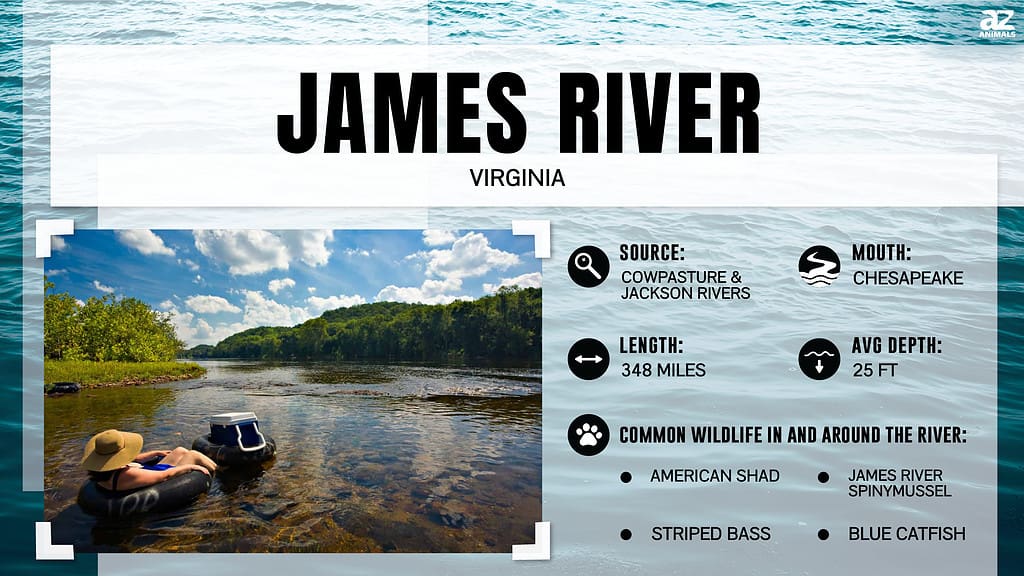
The Upper James River
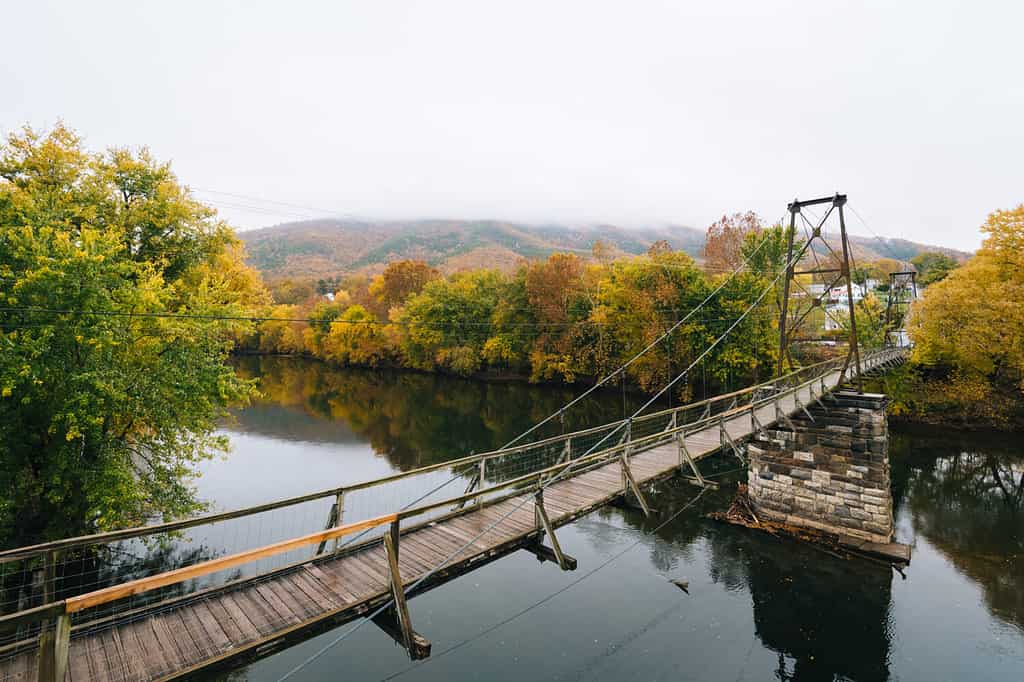
This swinging pedestrian bridge over the James River in Buchanan, VA was built in 1938.
©Jon Bilous/Shutterstock.com
Rivers all start somewhere as small trickles you could dam up with your foot. For the James River, those trickles start in the Appalachian Mountains. The headwaters of the James are the Cowpasture River and the Jackson River. They both start in Highland County on the West Virginia border and merge in Botetourt County near Clifton Forge to form the James. Down to Lynchburg, this area is considered the upper James River. Here, the river is wide and shallow over most of its course, sometimes just a few feet deep, and easy to wade across at many places, especially during the summer months when it is drier. This area offers plenty of beautiful mountain views as you’re fishing, tubing, and camping.
The Middle James River
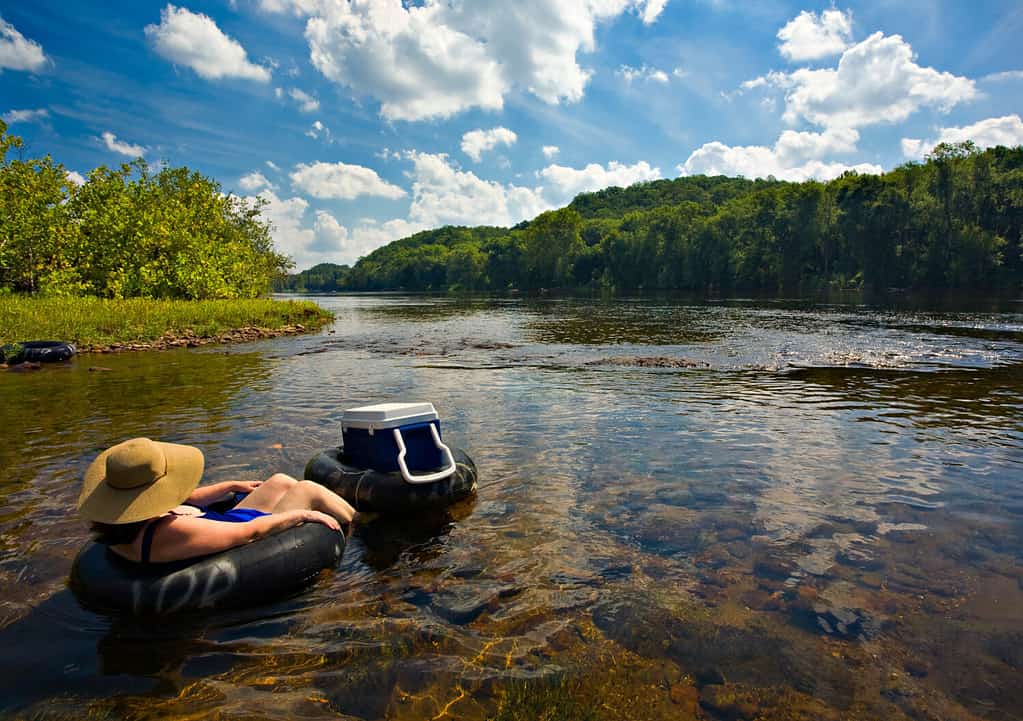
Inner tubing is a favorite form of recreation on the wide, lazy portions of the James River.
©jack looney photography/Shutterstock.com
The James River crosses the Blue Ridge Mountains through gorges to the northwest of Lynchburg. Balcony Falls is one of the significant drops of the river. It is located near Glasgow and Natural Bridge. From there the middle portion of the James River winds its way through the hilly, rural Piedmont region and drops a total of 84 feet in elevation before reaching Richmond. Over the centuries many dams have been built across the river in this region and have failed or been removed. Eight remain, providing hydroelectric power and reservoir impoundments for recreation and reserve water for times of drought.
The James reaches its northernmost point by making a dramatic loop at Scottsville. At this point, it’s about 3-6 feet deep depending on rainfall. Fishing and inner tubing is hugely popular there and it’s considered a safe and fun location for beginners. James River Reeling and Rafting rents inner tubes, kayaks, canoes, and even coolers at reasonable rates, making this a memorable and relaxing experience for families and groups. For most of its course, the James is broad and shallow, but around Goochland County it begins to have some deeper holes that are good for fishing but can be hazardous to swimmers and waders.
The Lower James River
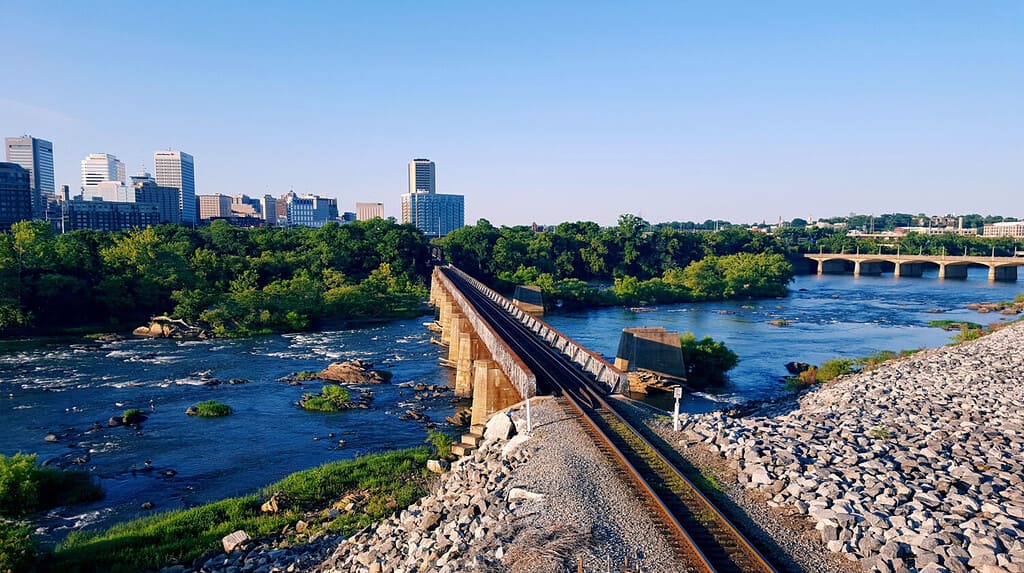
There are class III and IV rapids in the James River within sight of downtown skyscrapers.
©casualskydiving/Shutterstock.com
Richmond is where the falls of the river are located – the point at which ships cannot navigate further inland. Historically, many of the great cities of the world have grown at such places, where ships had to unload, and goods had to be transferred to land conveyances for shipping to inland locations. James River Park is a good place to enjoy water-based recreation. You can even go white-water rafting in Richmond, with class III (beginner) to class IV (intermediate to advanced) rapids within sight of the downtown skyline!
From the Richmond Locks down to the Chesapeake Bay, the federal government has dredged a channel 18-25 feet deep to make it navigable for cargo barges and smaller ships. However, modern ocean-going container ships can only go as far as Norfolk on the Bay, as they need a depth of at least 50 feet. This has caused Richmond to decline in importance as a seaport over the past century. What should be a 60-mile journey as the crow flies actually takes more than 100 miles by river because it loops and twists so much in the flat terrain. At about the halfway point between Richmond and Norfolk is Jamestown Island, the site of Jamestown. founded in 1607, this was the first permanent English settlement in the New World.

The James River empties into Chesapeake Bay, the largest estuary in the United States.
©Nature’s Charm/Shutterstock.com
The mouth of the James widens to a whopping five miles as it reaches the Chesapeake Bay. It merges with the Elizabeth River and the Nansemond River in a harbor area called Hampton Roads. From there, a channel leads to the Bay and out to the Atlantic Ocean.
Wildlife In and Around the James River
The James River watershed is without a doubt one of the most significant and diverse wildlife habitats in the state. The Living Shoreline Collaborative is one of the organizations working with landowners and local governments along the course of the river to manage adjacent land in ecologically sound ways to preserve the habitat. These are some of the species you might find as you explore the river:
Fish
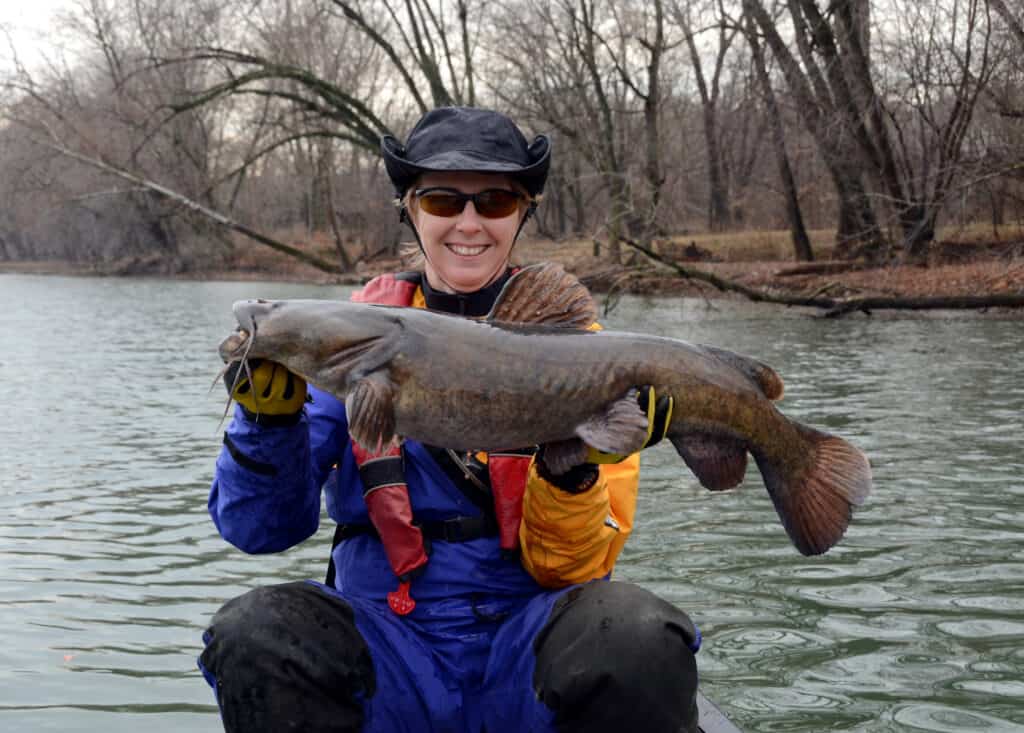
Flathead catfish can grow quite large and take some skill to catch.
©M. Huston/Shutterstock.com
From its headwaters to Richmond, the James River is home to channel catfish, bluegill, rock bass, redbreast, and flathead catfish, as well as smallmouth, largemouth, and spotted bass. Muskies are stocked in the river every year. They’re mostly found upstream of Lynchburg.
Birds
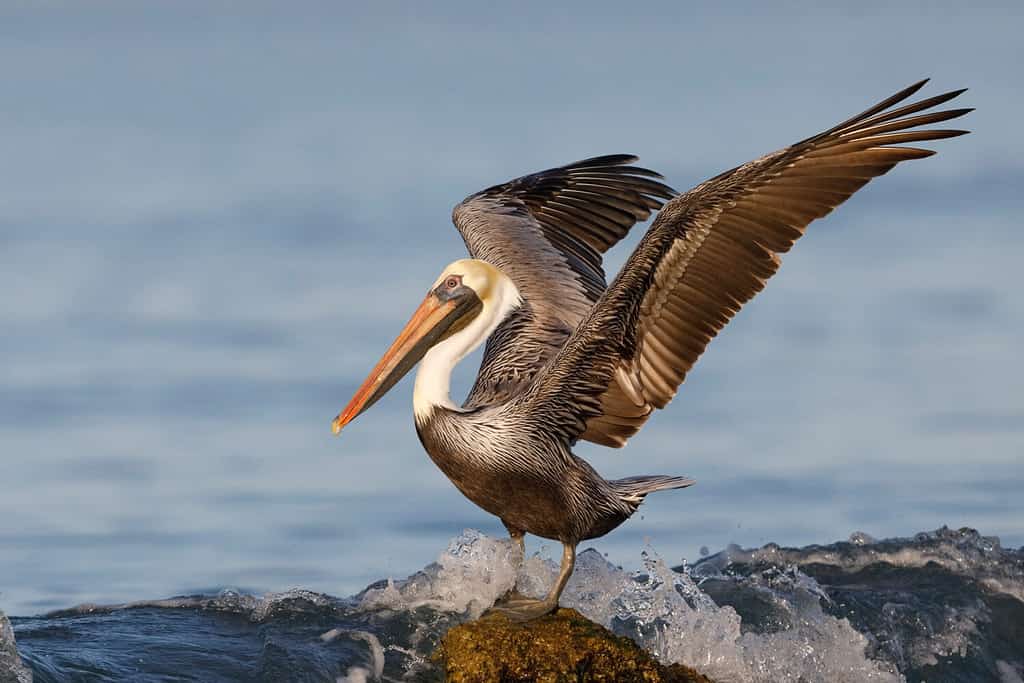
Virginia is the farthest north that brown pelicans nest year-round.
©Brian Lasenby/Shutterstock.com
Some of the bird species you could spot while hiking or rafting on the James are herons, Canada geese, hawks, bald eagles, mallards, cardinals, blue jays, and red-winged blackbirds. Closer to the ocean you’ll see plenty of seagulls and a pelican or two. Virginia is the northernmost state where brown pelicans live year-round.
Reptiles
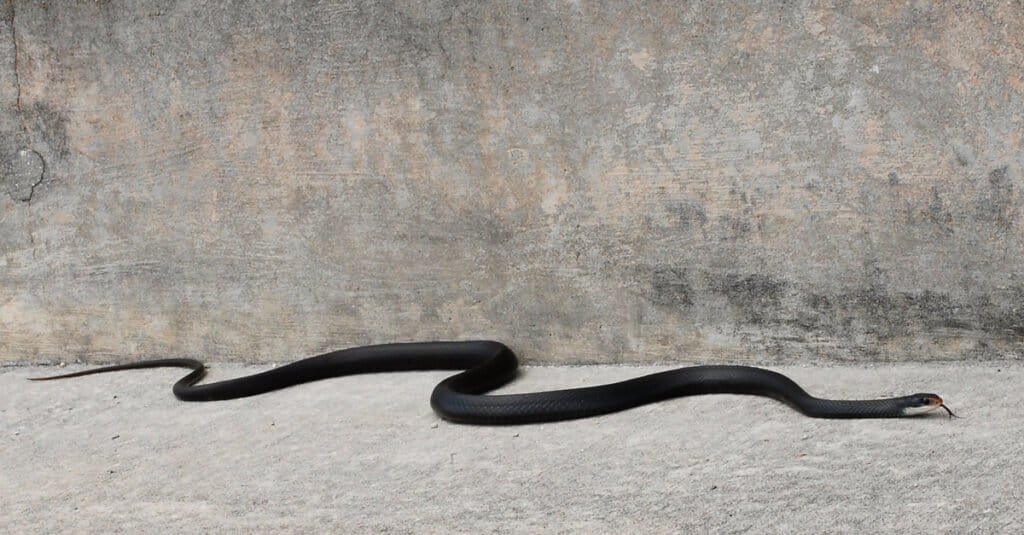
Black racers are large snakes ubiquitous in Virginia. Farmers appreciate them for eating mice.
©Perry Correll/Shutterstock.com
Depending on where you are along the river’s course, in or near the river you could encounter northern water snakes, copperheads, cottonmouth moccasins, garter snakes, black racers, or timber rattlesnakes. If you see any, leave them alone, and don’t even think about killing one. Killing snakes is illegal in the state and can get you a fine of $1,000 and six months in jail.
Mammals

River otters are cuties. If you spot one, consider yourself fortunate!
©iStock.com/Mirko_Rosenau
Mammal species abound in Virginia, particularly along its river systems. Keep an eye out for white-tailed deer, raccoons, river otters, muskrats, opossums, chipmunks, red foxes, and groundhogs. In the mountains and even on rare occasions in Central Virginia you might even spot a black bear.
A Humble but Important River

Jamestown, Virginia is where British colonization of the New World first gained a solid foothold.
©Kathy Clark/Shutterstock.com
For most of its distance, the James River can seem unimpressive. Its headwaters start out more like creeks. For much of the middle portion, you can swim or wade across. And in its final stretch to the sea, it’s not deep enough for the larger oceangoing vessels. Yet the James was historically significant as the site of the first permanent English settlement and the route early colonists took exploring and settling the interior of the state. it was truly where America’s westward expansion “from sea to shining sea” began. Today it is used mainly as a source of recreation and a water supply rather than as a shipping route. But it remains a vital wildlife habitat as it has been for millennia and will be in the future. It all goes to show, you don’t have to be particularly deep to be important.
The photo featured at the top of this post is © Xavier Ascanio/Shutterstock.com
Thank you for reading! Have some feedback for us? Contact the AZ Animals editorial team.






